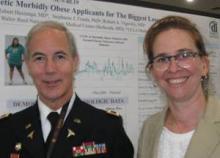HOUSTON – Data from 42 morbidly obese people who applied to be on the television show "The Biggest Loser" showed significantly greater glycemic variability even without diabetes, compared with previous data on nondiabetic, normal-weight adults.
Oxidative stress from the glycemic variability may contribute to microvascular and macrovascular changes in obese people and help explain why some obese people develop advanced cardiovascular disease and increased risk for cardiovascular events, investigators said at the annual meeting of the Endocrine Society.
"The Biggest Loser" applicants wore a masked continuous glucose monitor for 3-8 days as part of the application process. Four patients with type 1 or type 2 diabetes were excluded from the analysis, leaving 23 people with normal glucose tolerance and 15 who were classified as having prediabetes. The investigators compared the swings between high and low glucose readings in these 38 patients with historic data on 37 age-matched, nondiabetic, normal-weight people from the Juvenile Diabetes Research Foundation Continuous Glucose Monitoring Study Group (Diabetes Care 33;6:1297-9).
The average hemoglobin A1c was 5.3% in the normoglycemic but obese applicants and 5.4% in the nonobese control group, compared with 5.8% in the obese applicants.
The standard deviation in glucose measures was 24 mg/dL in both the normoglycemic applicants and the prediabetic applicants, compared with 12 mg/dL in the nonobese control group, Sara J. Salkind and her associates reported. Other standard measures of glycemic variability showed similar trends. The mean amplitude of glycemic excursion was 48 mg/dL in the normoglycemic applicants and 50 mg/dL in the prediabetic group, compared with 27 mg/dL the control group.
The percentage of glucose values that fell within the range of 81-139 mg/dL was 77% in the normoglycemic applicants and 78% in the prediabetic group, compared with 99% in the control group. Glucose values below 80 mg/dL comprised 11% of values in the "normal" obese group and 5% of values in the prediabetes group, compared with 0.3% of values in the control group. Glucose values higher than 140 mg/dL comprised 12% of measures in the "normal" obese group, 18% of measures in the prediabetes group, and 0.3% of values in the control group.
If "normal" glycemic status is defined as a HbA1c less than 5.7%, a fasting glucose level less than 100 mg/dL, and a 2-hour postprandial glucose load of less than 140 mg/dL, then "these obese people, who by almost all the traditional measures have normal glycemia, have increased variability and much greater variability than normals of similar age" who are not obese, coinvestigator Robert A. Vigersky, Col., MC, USA, said in an interview.
Both Ms. Salkind and Dr. Vigersky are with the endocrinology service at Walter Reed National Military Medical Center, Bethesda, Md. The investigators’ report reflects the personal views of the authors and not the official views of the United States Army or the Department of Defense.
People with diabetes are known to have glycemic variability, but there are few previous data on glycemic variability in people without diabetes. The current findings have implications for the pathophysiology of microvascular disease and, combined with previous studies suggesting that obese people have increased carotid intima-media thickness, compared with normal-weight people, may increase understanding of cardiovascular risk from obesity.
Measures of glycemic variability also may have a more practical application as a behavior-modification tool to help obese people understand the effects of their eating habits on their bodies. The investigators said they will pursue studies to see if continuous glucose monitoring might help obese patients lose weight and avoid converting to prediabetes or diabetes.
The average age in the current study was 32 years in the "normal" group and 34 years in the prediabetes group. The average body mass index was 50 and 51 kg/m2, respectively. The 2-hour post-glucose load averaged 107 mg/dL for normoglycemic applicants and 145 mg/dL in the prediabetes group. The fasting plasma glucose averaged 89 mg/dL in the "normal" group and 97 mg/dL in the prediabetes group. Hypertension was present in 76% and 93%, respectively.
Dexcom, which makes continuous glucose meters, funded the study. The investigators reported having no other financial disclosures.


